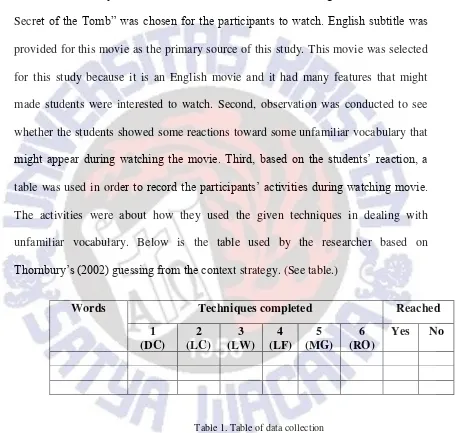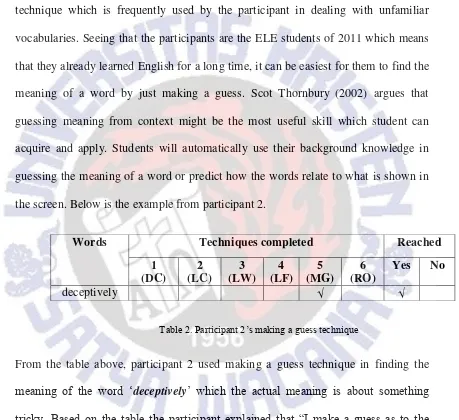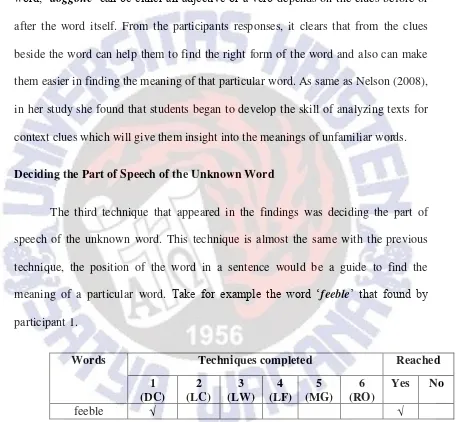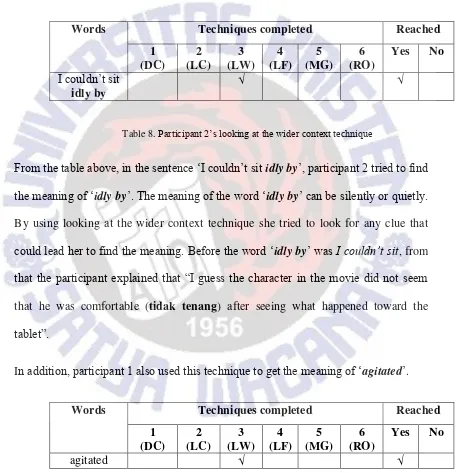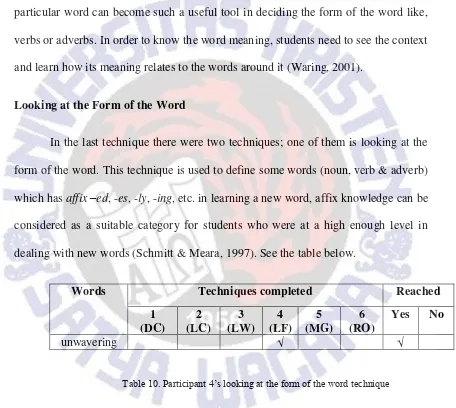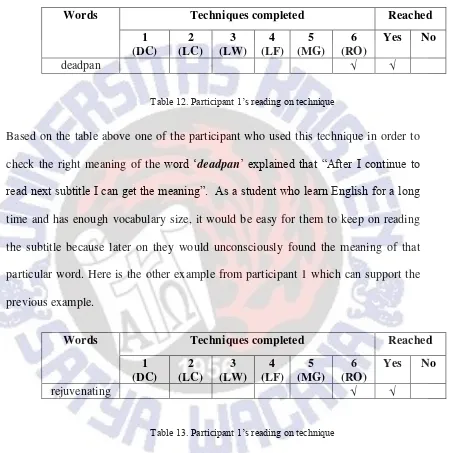i
TECHNIQUES IN GUESSING FROM THE CONTEXT WHEN
WATCHING A MOVIE WITH ENGLISH SUBTITLE
THESIS
Submitted in Partial Fulfillment
of the Requirements for the Degree of
Sarjana Pendidikan
Janoviana Palelia De Fatima Gomes I
112011901
ENGLISH LANGUAGE EDUCATION PROGRAM
FACULTY OF LANGUAGE AND LITERATURE
SATYA WACANA CHRISTIAN UNIVERSITY
SALATIGA
ii
TECHNIQUES IN GUESSING FROM THE CONTEXT WHEN
WATCHING A MOVIE WITH ENGLISH SUBTITLE
THESIS
Submitted in Partial Fulfillment
of the Requirements for the Degree of
Sarjana Pendidikan
Janoviana Palelia De Fatima Gomes I
112011901
ENGLISH LANGUAGE EDUCATION PROGRAM
FACULTY OF LANGUAGE AND LITERATURE
SATYA WACANA CHRISTIAN UNIVERSITY
SALATIGA
iii
TECHNIQUES IN GUESSING FROM THE CONTEXT WHEN
WATCHING A MOVIE WITH ENGLISH SUBTITLE
THESIS
Submitted in Partial Fulfillment of the Requirements for the Degree of
Sarjana Pendidikan
Janoviana Palelia De Fatima Gomes I 112011901
Approved by:
____________________________ _____________________________ Dian Toar Y. G. Sumakul , M.A. Maria Christina Eko Setyarini, M.Hum.
iv
COPYRIGHT STATEMENT
This thesis contains no such material as has been submitted for examination in any course or accepted for the fulfillment of any degree or diploma in any university. To the best of my knowledge and my belief, this contains no material previously published or written by any other person except where due reference is made in the text.
Copyright@ 2015. Janoviana Palelia De Fatima Gomes I and Dian Toar Y. G. Sumakul, M. A
All rights reserved. No part of this thesis may be reproduced by any means without the permission of at least one of the copyright owners or the English Department, Faculty of Language and Literature, SatyaWacana University, Salatiga.
v
PUBLICATION AGREEMENT DECLARATION
As a member of the (SWCU) SatyaWacana Christian University academic community, I verify that:
Name : Janoviana Palelia De Fatima Gomes I Student ID Number : 112011901
Study Program : English Language Education Program Faculty : Language and Literature
Kind of Work : Undergraduate Thesis
In developing my knowledge, I agree to provide SWCU with a non-exclusive royalty free right for my intellectual property and the contents there in entitled:
Techniques in Guessing From the Context When Watching a Movie with English Subtitle
along with any pertinent equipment.
With this non-exclusive royalty free right, SWCU maintains the right to copy, reproduce, print, publish, post, display, incorporate, store in or scan into a retrieval system or database, transmit, broadcast, barter or sell my intellectual property, in whole or in part without my express written permission, as long as my name is still included as the writer.
This declaration is made according to the best of my knowledge.
Made in : Salatiga Date :
Verified by signee,
Janoviana Palelia De Fatima Gomes I Approved by
Thesis Supervisor Thesis Examiner
vi
TABLE OF CONTENTS
Cover Page ………..……….. i
Inside Cover Page ……… ii
Approval Page ………... iii
Copyright Statement ………iv
Publication Agreement Declaration ……….……….………... v
Table of Content ……… vi
List of Graph ………..…………. viii
List of Tables ………..……….. .. ix
Introduction ……… 1
Literature Review Incidental Vocabulary Learning …………..………. 3
Relationship between Reading and Incidental Vocabulary Learning ……4
Guessing from the context …... 5
Methodology Context of the Study ……… 8
Participants ……… 8
Instruments of Data Collection ……… 9
vii
Data analysis ………..……….…...11
Findings and Discussion Making a Guess ………...….. 13 Looking for Further Clues in the Words Immediate Collocates …... 14
Deciding the Part of Speech of the Unknown Word …...………….. 16
Looking at the Wider Context ….………... 17
Looking at the Form of the Word ………. 19
Reading On ………..……….….……. 20
Factors Affecting “Making a guess” ……….…... 22
Combined Techniques ……….…….... 23
Conclusion ………..…... 26
Acknowledgment ………..…... 28
References ………..…... 29
viii
List of Graph
ix
List of Tables
Table 1. Table of data collection ………...….… 9
Table 2. Participant 2‟s making a guess technique ...………....……...….. 13
Table 3. Participant 4‟s making a guess technique ………... 14
Table 4. Participant 1‟s looking for further clues technique ……...…….. 15
Table 5. Participant 2‟s looking for further clues technique ……….….... 15
Table 6. Participant 1‟s deciding the part of speech technique …..…... 16
Table 7. Participant 3‟s deciding the part of speech technique …….….... 17
Table 8. Participant 2‟s looking at the wider context technique …….…. 18
Table 9. Participant 1‟s looking at the wider context technique …….…. 18
Table 10. Participant 4‟s looking at the form of the word technique …....19
Table 11. Participant 5‟s looking at the form of the word technique …....20
Table 12. Participant 1‟s reading on technique ………... 21
Table 13. Participant 1‟s reading on technique ………... 21
Table 14. Combined techniques ………..…...…...….. 24
1
TECHNIQUES IN GUESSING FROM THE CONTEXT WHEN
WATCHING A MOVIE WITH ENGLISH SUBTITLE
Janoviana Palelia De Fatima Gomes I – 112011901 Abstract
The use of English subtitle in watching movie for students can enrich their vocabulary and also it can teach them on how to deal with some unfamiliar vocabulary. This study tried to investigate on how the second language students use the techniques of guessing from the context in finding the meaning of unfamiliar vocabulary they found when watching movie. The data consisted of the result of observation and interview of bilingual students of the Faculty of Language and Literature, Satya Wacana Christian University which were extracted, classified, and gathered into several categories based on the six techniques of guessing from the context by Thornbury (2002). This discussion used the clear transcription of the interview result to classify the answers belong to the classification provided. The classifications of 5 responses were arranged based on the answer of the participants. The findings suggested that making a guess technique used by the participants was the main technique in dealing with unfamiliar vocabulary when watching a movie with English subtitle. For more substantial results in the future, researchers may consider larger numbers of participants to observe the use of movie subtitle in vocabulary learning process. This study was expected to give a new way for students to enrich their vocabulary and improve their language skills when watching movie with English subtitle.
Keywords: Vocabulary, movie subtitle, guessing from the context.
INTRODUCTION
There are many ways to learn new vocabularies that usually involve audio
visual aids like pictures, songs, videos or movies. It will encourage the students‟
2
educational goals with entertainment content. It means that students do not watch or use media only to have fun but they also can be quite educational. Through watching movies students could be motivated in learning foreign language. In watching movies with subtitle learners do not only use their listening skill but also use their reading skill at the same time for their comprehension. While reading the subtitle, the incidental vocabulary learning may occur unconsciously. As Nation (2001) defines, incidental vocabulary learning can facilitate the learning process by providing a meaningful context, while the attention of the students in some other features of foreign language.
There have been several studies focused on the use of movie subtitle/caption
can enrich the learners‟ language ability. As one of the studies is from Hu and
Huang‟s (2013) experiment, it showed that watching videos with subtitles, especially
English subtitle could help the students identify the word or expression from the stream of speech and the context together with the pictures provide them with hints to infer its specific meaning in the video. Moreover, they also found out that the students had a positive attitude toward viewing video with subtitle and believed that they could learn more words by watching videos with English subtitles.
3
development process, ELE students will go through many techniques to rehearsal or improve their language skills. One of the rehearsal methods is for example: when they face a difficulty to understand unfamiliar vocabulary during watching English movie with subtitle, they will go through many techniques to get the meaning. Thus, this study was conducted to find what are the strategies that used by the students in dealing with the unfamiliar vocabulary in watching English movie. In other words,
this study was trying to answer the following research question: “What is the technique used by ELE students in dealing with the unfamiliar vocabularies that they found while watching a movie with English subtitle?”
Considering the importance of vocabulary knowledge for EFL learners, this study is expected to give a new way for the students in order to enrich their vocabulary. Through watching movie with English subtitle they can also improve their language skills and use their background knowledge in order to deal with unfamiliar vocabulary. Besides, the researcher also hopes that the information from this study can give solutions for EFL students in finding the meaning of words.
Incidental Vocabulary Learning
4
part of vocabulary acquisition (Hong, 2010). In Paribakht and Wesche‟s definitions
(1999), incidental vocabulary learning refers to the process where students focus on understanding the meaning of reading and listening context rather than the accidental vocabulary learning and acquire vocabulary as a "by-product" without a
consciousness of students‟ decision, or intention to learn the words. In addition,
Fraser (1991) as cited in Karakas and Sariçoban (2011) some incidental vocabulary learning occurs through reading for comprehension and also through the process of inferring word meaning from the context.
Additionally, Nagy, Herman, & Anderson (1985) claimed that when the incidental vocabulary acquisition encouraged by a contact with a sufficient amount of exposure to written language, incidental vocabulary acquisition would be enormous. Many experts also have agreed that most of second language vocabulary acquisition is learned incidentally while students are agreed in extensive reading (ER) or reading comprehension and inferring the meanings of unknown words.
Relationship between Reading and Incidental Vocabulary Learning
Incidental vocabulary learning often occur while reading, according to Nation (2001: 232) the importance of incidental learning by “message focused activities” as
5
language items, with direct study of language items occupying no more than 25% of
the total learning program”.
Similarly, Huckin and Coady (1999: 182) also indicated that “except for the
first few thousand most common words, vocabulary learning dominantly occurs through extensive reading, with the learner guessing at the meaning of unknown
words”. As the result of successes in the acquisition of words from a meaningful context and by more reading experiences the inference of vocabulary ability would be developed and matured and could contributes to reading level. Therefore, reading has an important role in incidental vocabulary learning because through reading students can develop or enrich their vocabulary knowledge. In the process of incidental vocabulary learning, word knowledge is allegedly to be cumulated and developed gradually through multiple exposures in various reading contexts (Hong, 2010). In other words, the acquisition of words is the result of successes in inferring word meanings from a meaningful context through more reading experiences.
Guessing from the context
6
use in dealing with unfamiliar vocabulary is guessing from the context. According to Scott Thornbury (2002:148) who argues that guessing from context is probably one of the most useful skills students can acquire and apply both inside and outside the classroom. Still, it seems to be one that can be taught and implemented relatively easily. It is also one that we all already used, perhaps unconsciously when reading and listening in other language such as English. In addition Thornbury (2002: 148) also recommends the following strategy for guessing from the context:
Deciding the part of speech of the unknown word whether, for example, it is a noun, verb, adjective, etc. Its position in the sentence may be a guide, as might its ending (e.g. an –ed or –ing ending might indicate it is a verb). For example: Totally annoyed, there is and –ed at the end of the word annoyed which indicates it is an adjective.
Looking for further clues in the word‟s immediate collocates, if it is a noun, does it
have an article (which might suggest whether it is countable or not)? If it is a verb,
does it have an object or not. For example: He won‟t swallow his food. Swallow is a verb because after the verb there is an object which is his food.
Looking at the wider context, including the surrounding clauses and sentences,
7
Looking at the form of the word technique is used to get more clues which can lead to find the right meaning of a particular word. By seeing the affix of a word students might easily find the form of the word before they understand the meaning. For example: downhearted is made up of down + heart + a participle affix (-ed).
Making a guess technique is used to find the meaning of the word, as the basis of the above techniques. When an unfamiliar word appeared students will automatically trying to guess what is the meaning of that particular word. In order to make a guess they tend to use their background knowledge in learning foreign language. For example: If you peelthe potatoes, I‟ll cut them. The word peel in that sentence means
„to remove the skin‟, thus it should be peel first before cut.
8
THE STUDY
Context of the Study
This research is a qualitative research for the reason that this research is aimed to find out about the use of guessing from the context strategy by the final year of ELE students in watching English movie with subtitle. Students understanding in dealing with unfamiliar vocabulary were analyzed to see their technique that they used during watching English movie with subtitle. The setting of the study was conducted in Faculty of Language and Literature (English Language Education Program – ELE) at Satya Wacana Christian University (SWCU), Salatiga, Central Java, Indonesia. The reason for selecting this university due the researcher was studying in SWCU, thus it would be more practical to collect the data since it saved time and speeded up the data collection process.
Participants
The participants for this study were 5 ELE students of 2011. The participants
9
Instruments of Data Collection
In this study, first a 97 minute movie with the title “Night at The Museum:
Secret of the Tomb” was chosen for the participants to watch. English subtitle was provided for this movie as the primary source of this study. This movie was selected for this study because it is an English movie and it had many features that might made students were interested to watch. Second, observation was conducted to see whether the students showed some reactions toward some unfamiliar vocabulary that
might appear during watching the movie. Third, based on the students‟ reaction, a
table was used in order to record the participants‟ activities during watching movie. The activities were about how they used the given techniques in dealing with unfamiliar vocabulary. Below is the table used by the researcher based on
Thornbury‟s (2002) guessing from the context strategy. (See table.)
Words Techniques completed Reached
1
Table 1. Table of data collection
Technique 1 (DC) : Deciding the part of speech of the unknown word
Technique 2 (LC) : Looking for further clues in the words immediate collocates
Technique 3 (LW) : Looking at the wider context
10 Technique 5 (MG) : Making a guess
Technique 6 (RO) : Reading on
The first column was for the unfamiliar words which the participants wanted to find out the meaning. Second column was for the technique they used at that time and the third was for the confirmation of the technique, whether it was worked or not. Furthermore, an interview would be conducted immediately based on the table that was already filled. It was used to obtain more detail information and to know their techniques in dealing with unfamiliar vocabulary.
Procedure of Data Collection
Prior to data collection, 5 ELE students of 2011 would be chosen to participate in this study. After that, the students would watch the movie twice which at first they would watch the whole movie and for the second time observation was conducted during watching the movie. In this part, students‟ reaction or what happened while watching the movie was observed.
Next, a semi-structured interview would be conducted in order to answer some questions based on the result of the observation, which was mostly related to
students‟ reaction. It was used to get more data from the students by comparing their
11
vocabulary. The maximal length of time for the interview was 10 minutes (clean transcription). The last, students would be given more opportunities to share their experiences when they applied their technique during watching English movie.
Data Analysis
After finishing the data collection and transcribing the interview, the data were analyzed using the holistic-content analysis which is focusing on the entire interview transcript for each participant. After reading the transcript/notes of each participant, a major theme would be decided to focus on analyzing the data. Re-read
12
FINDING AND DISCUSSION
The finding of this study indicates that all six techniques by Thornbury (2002) can be used to find the meaning of unfamiliar vocabulary during watching English movie with subtitle. Below is the diagram that shows the classification of techniques. (See Graph 1).
Graph 1: The Diagram shows the number of technique occurrences based on Thornbury‟s (2002) strategy of guessing from the context
From the diagram above, out of 12 occurrences of the technique is categorized under technique 5 which is making a guess of the word. Eight (8) occurrences fall under technique 2 looking for further clues. Five (5) occurrences are under two techniques, technique 1 deciding part of the speech and technique 3 looking at the wider context. Four (4) occurrences are under two techniques, technique 4 looking at the form of the word and technique 6 reading on.
0 2 4 6 8 10 12 14
13
Making a Guess
In this study, making a guess technique accounted the largest number of technique which is frequently used by the participant in dealing with unfamiliar vocabularies. Seeing that the participants are the ELE students of 2011 which means that they already learned English for a long time, it can be easiest for them to find the meaning of a word by just making a guess. Scot Thornbury (2002) argues that guessing meaning from context might be the most useful skill which student can acquire and apply. Students will automatically use their background knowledge in guessing the meaning of a word or predict how the words relate to what is shown in the screen. Below is the example from participant 2.
Words Techniques completed Reached
1
Table 2. Participant 2‟s making a guess technique
From the table above, participant 2 used making a guess technique in finding the
meaning of the word „deceptively‟ which the actual meaning is about something
tricky. Based on the table the participant explained that “I make a guess as to the
14
the word. It is similar with participant 4 who also used this technique to find the meaning of „glitterati‟.
Words Techniques completed Reached
1
Table 3. Participant 4‟s making a guess technique
Participant 4 explained that in making a guess to find the meaning of the word
„glitterati‟, she also used her background knowledge and looked for the context of the
sentence to know the meaning. From here we can see that by seeing some particular context (picture shown on the screen) the participants could get the possible meaning of the particular word. It is related to Dole, Sloan & Trathen (1995) who reported that students were able to see how words relate directly to the plot, theme, and characters in the selections. These activities can lead students to the deep processing in word learning and comprehension improvement. Wilson (2000) also suggests that images contextualized in video or on its own can help to reinforce language learning, provided the student can see immediate meaning in terms of vocabulary recognition.
Looking for Further Clues in the Words Immediate Collocates
15
article or whether if it is a verb then does it have an object. Vanderplank (1988:272) also says that subtitles have potential value in helping the language and vocabulary acquisition process. It flows by providing language students with the stimulus and clues from giving quantities of authentic and comprehensible language input.Below is the table of participant 1.
Words Techniques completed Reached
1
Table 4. Participant 1‟s looking for further clues technique
In this case participant 1 used this technique to find the meaning of the word
„constellations‟. According to the participant, she just guessing it from the position of
the word and she also added that: “There is an article in front of the word so I
conclude that it is a noun”. It means that subtitle can make it easier to find out the
meaning since the participant had an ability to see, predict, analyze and know the position of some words before and after the unfamiliar word. There is another example from participant 2, below is the table.
Words Techniques completed Reached
1
16
To find the meaning of the word „doggone‟, participant 2 said that “Guess based on
the position, I immediately guess doggone as verb”. Based on the position of the
word, „doggone‟ can be either an adjective or a verb depends on the clues before or after the word itself. From the participants responses, it clears that from the clues beside the word can help them to find the right form of the word and also can make them easier in finding the meaning of that particular word. As same as Nelson (2008), in her study she found that students began to develop the skill of analyzing texts for context clues which will give them insight into the meanings of unfamiliar words.
Deciding the Part of Speech of the Unknown Word
The third technique that appeared in the findings was deciding the part of speech of the unknown word. This technique is almost the same with the previous technique, the position of the word in a sentence would be a guide to find the meaning of a particular word. Take for example the word „feeble‟ that found by
participant 1.
Words Techniques completed Reached
1
Table 6. Participant 1‟s deciding the part of the speech technique
By using this technique the participant decided the part of the speech of the unknown
17
since it has noun at the end of this word. It means that the position in the sentence can
be a guide”. Moreover, below is another example of this technique used by
participant 3.
Words Techniques completed Reached
1
Table 7. Participant 3‟s deciding the part of the speech technique
As showed in table 7, participant 3 tried to find the meaning of „dazzling‟. In this
context „dazzling‟ is referred to something bright or shine. Thus the participant
explained that “I considered dazzling as an adjective because when the speaker said
the sentences, there were shiny light like effects that shine from a building”. Based on
the two participants, Clarke & Nation (1980:218) once stated that guessing the meaning of unfamiliar words can develop reading skill. By guessing it, the participants would be able to consider the word, predict what will occur, and also confirm the prediction.
Looking at the Wider Context
18
that to know a word students need to see it in context relates to the word around
meanings and also they will begin to see how a word‟s meaning can change and shift
depending on its context. Here is the example of this technique used by participant 2.
Words Techniques completed Reached
1
Table 8. Participant 2‟s looking at the wider context technique
From the table above, in the sentence „I couldn‟t sit idly by‟, participant 2 tried to find
the meaning of „idly by‟. The meaning of the word „idly by‟ can be silently or quietly.
By using looking at the wider context technique she tried to look for any clue that
could lead her to find the meaning. Before the word „idly by‟ was I couldn’t sit, from
that the participant explained that “I guess the character in the movie did not seem
that he was comfortable (tidak tenang) after seeing what happened toward the
tablet”.
In addition, participant 1 also used this technique to get the meaning of „agitated‟.
Words Techniques completed Reached
1
19
After she found the right meaning of it, she said that “including the surrounding
clauses and sentences, especially if there are signposting words, such as seems and
fool”. From the answers we can see that „signposting‟ (connected) words around the particular word can become such a useful tool in deciding the form of the word like, verbs or adverbs. In order to know the word meaning, students need to see the context and learn how its meaning relates to the words around it (Waring, 2001).
Looking at the Form of the Word
In the last technique there were two techniques; one of them is looking at the form of the word. This technique is used to define some words (noun, verb & adverb) which has affix–ed, -es, -ly, -ing, etc. in learning a new word, affix knowledge can be considered as a suitable category for students who were at a high enough level in dealing with new words (Schmitt & Meara, 1997). See the table below.
Words Techniques completed Reached
1
Table 10. Participant 4‟s looking at the form of the word technique
Participant 4 who used this technique to find the meaning of the word „unwavering‟
said that “To guess the meaning of the word, I look the form of word to get the clues
whether it has an affixes”. In addition, there is another example from participant 5
20
Words Techniques completed Reached
1
Table 11. Participant 5‟s looking at the form of the word technique
It is similar with the example before that showed how participant 5 tried to find the
meaning by looking at the form of the word „clamoring‟. The meaning of
„clamoring‟ is shouting loudly, so from the suffix –ing the participant got the clues that could help her to find the meaning and also the form of the word. From that we can see how form of the word associated with each other, as Schmitt & Meara (1997) also said that as the links word associations could connect or relate words in some ways.
Reading On
21
Below is the example of reading on technique by participant 1.
Words Techniques completed Reached
1
Table 12. Participant 1‟s reading on technique
Based on the table above one of the participant who used this technique in order to check the right meaning of the word „deadpan‟ explained that “After I continue to
read next subtitle I can get the meaning”. As a student who learn English for a long
time and has enough vocabulary size, it would be easy for them to keep on reading the subtitle because later on they would unconsciously found the meaning of that particular word. Here is the other example from participant 1 which can support the previous example.
Words Techniques completed Reached
1
Table 13. Participant 1‟s reading on technique
Above is the evident from participant 1 who kept on reading in order to find the
meaning of the word „rejuvenating‟. She also gave the similar respond as the
previous participant, that “I read it more to get the meaning”. From both participants I
22
during watching movie. Even without using the other techniques mentioned above, just keep on reading the subtitle because there would be possibilities that we could find the meaning later on.
Factors Affecting “Making a guess”
Background knowledge and vocabulary knowledge are important factors that affect students in identifying unfamiliar words and expressions. Dealing with that condition, students will automatically use all their ability to get the meaning. Take for example when they are looking deeper on the pictures and subtitles, they will use their grammatical knowledge to hold a variety of things, from its word class and where it normally occurs in a sentence, to its morphological and syntactical characteristics. For example, during the interview, when further asked about the technique used, a participant explained, “Since I learn English becomes a foundation
to understand the meaning of unfamiliar words”. This is evident in some other participants as well. The role of background knowledge has been seen as important aspect in communication, particularly in foreign language interaction. In cases for EFL students, Clarke and Nation (1980) also say that students will use their knowledge in word parts to guess meaning of a word.
23
Norbert Schmiit (1997: 20) says that “background knowledge has some relationship
with both overall vocabulary and general language proficiency”. It means that a
people who have learnt non-native language as their study, they will have enough knowledge to understand the meaning of words. That‟s why the participants of this study have more chance to use making a guess technique as their technique to find and understand the meaning of unfamiliar words.
By guessing the meaning of unfamiliar words and then find those meaning it can give a chance for the students to remember that meaning and it can enrich their vocabulary knowledge. Besides, the use of this ability may not waste their time rather than referring to a dictionary in finding the meaning of the words (Clarke & Nation, 1980).
Combined Techniques
Graph 1 had indicated the classification of technique that was used by participants, but I also found some interesting case during analyze the data of this
24
Below is the example:
Words Techniques completed Reached
1
From table 1 the participant use technique 2 to examine the words came up after the word. After that she used technique 5 to make a guess to find the meaning of the
word, she said that “then I saw the movie and used my background knowledge”.
Students who have learned English for long time might automatically use their background knowledge and combined it with other different techniques to find the meaning of the word. There is another example of technique combination used by the participants.
Words Techniques completed Reached
1
From the table above the participant combined technique 2 and 3 to find the meaning
of the word „patronage‟. Technique 2 was chosen by the participant as guessing
25
which means that it is a noun. After that, she used looking at the form of the word
26
Conclusion
Nowadays there are many ways in learning new vocabulary words, take for example in dealing with unfamiliar vocabulary which found when watching movie with English subtitle. In this study the Indonesian – English bilingual University undergraduates were analyzed based on the strategy framework from Thornbury (2002). The finding shows that making a guess using background knowledge is the fastest way to find meaning of a particular word and also will not waste time to look into the dictionary. It is more or less similar with other studies used subtitle as an instructional method since it was invented for second language learners in vocabulary learning and understanding communications in video or movie. The result of the study supports Hu and Huang (2013) findings where students can identify the words and expressions using their background knowledge in getting the specific meaning in a certain video or movie.
Furthermore, this study will add to the existing literature about movie subtitle in learning vocabulary. Information gained from the study will help to provide the solutions in finding meaning of words during watching movie with English subtitle. In addition, the techniques that used in this study can give more data about how the techniques can be useful for EFL students in the process of learning new vocabulary.
27
28
ACKNOWLEDGEMENT
First of all, I want to thank God for always helping me from the beginning of my study until the end of my thesis submission.
On this occasion with great humility, I would like to thank all of those who have given me help and guidance so that this thesis can be finished. Completion of writing of this thesis, I would like to thank to:
1. My Family who always support me in every condition during my study. 2. My supervisor, Dian Toar Y. G. Sumakul M.A. Thank you for the
guidance, assistance, and patience from the beginning until the end of my thesis.
3. My examiner, Maria Christina Eko Setyarini, M.Hum. Thank you for examining my thesis.
4. My best friends, Ragil and Martina. My college life here would be incomplete if I did not meet and be friend with both of you.
5. To all of my college friends (Gracesia, Freda, Warida and Regina) for
the joy, laugh, suggestions and ideas during our togetherness. There‟s
29
References
Blackledge, A. (2001). Complex positioning: Women negotiating identity and power in minority urban setting. In A. Plavenko, A. Blackledge, I. Piller & M. Teutsch-Dwyer (Eds, Mul;tilingualism, second language learning and gender. Berlin: Mouton de Gruyter.
Brown, J. D., & Rodgers, T. S. (2002). Doing second language research. New York: Oxford University Press.
Canning – Wilson, C. (2000). Practical Aspects of Using Video in the Foreign Language Classroom, in The Internet TESL Journal, 11(6).
Clarke, D.F. & Nation, I.S.P. (1980) Guessing the meanings of words from context: strategy and techniques. System ,8(3), 218.
Dole, A.J., & Sloan, C., & Trathen, W. (1995). Teaching Vocabulary within the Context of Literature. Journal of Reading, 38(6), 452-460.
Edwards, L. (2009). How to teach Vocabulary. Pearson Education. Retrieved from <http://pearsonlongman.com.html>.
Fraser, C.A. (1991). Lexical processing strategy use and vocabulary learning through reading. In Karakash, A., & Saricoban, A. (Ed.) The impacts of Watching subtitled animated cartoons on incidental vocabulary learning of ELT students. Mehmetakif.academia.edu.
Hong, X. (2010). Review of effects of glosses on incidental vocabulary learning and reading comprehension. Chine Journal of Applied Linguistic. 33(1).
Hu, J. & Huang, L. (2013). Subtitles and Chinese EFL Learners' Vocabulary Acquisition.
Huckin, T. & Coady, J. (1999). Incidental Vocabulary acquisition in a second language. Studies in Second Language Acquisition, 21, 182.
Hunt, A. & Beglar, D. (1998). Current research and practice in teaching vocabulary.
The Language Teaching Online Journal. 22(1).
Johnson, C., & Johnson, D. (2012). Why teach vocabulary? June 18, 2012. Retrieved from
http://eps.schoolspeacialty.com/downloads/articles.why_teach_vocabulary.p df
Krashen, S. (2004). The Case of Narrow Reading. Language Magazine 3(5): 17-19. Nagy, W. E., Herman, P. A., & Anderson, R. C. (1985). Learning words from
30
Nation, I. S. P. (2001). Learning Vocabulary in Another Language. Cambridge University Press.
Nelson, D.L. (2008). A Context-Based Strategy for Teaching Vocabulary. English Journal, 97(4), 33-37.
Purushotma, R. (2005). Commentary: You're Not Studying, You're Just... Language Learning & Technology, 9(1).
Schmitt, N. & Meara, P. (1997). Researching Vocabulary Through a Word Knowledge Framework. Word Associations and Verbal Suffixes. 20. Shang, H. F. (2010). Reading Strategy Use, Self-Efficacy and EFL Reading
Comprehension. The Asian EFL Journal Quarterly. 12 (2). Thornbury, S. (2002). How to Teach Vocabulary. Harlow: Longman.
Vanderplank, R. (1988). The Value of Teletext Sub – titling in Language Learning.
ELT Journal. 42, 272-281.
Waring, R. (2001). Research in extensive reading. Studies in Foreign Language and Literature, 25(1), 44–67. Retrieved from
http://www.robwaring.org/papers/various/kiyo2001.html.
31
APPENDIX
Words Techniques completed Reached
1 (DC)
2 (LC)
3 (LW)
4 (LF)
5 (MG)
6 (RO)
